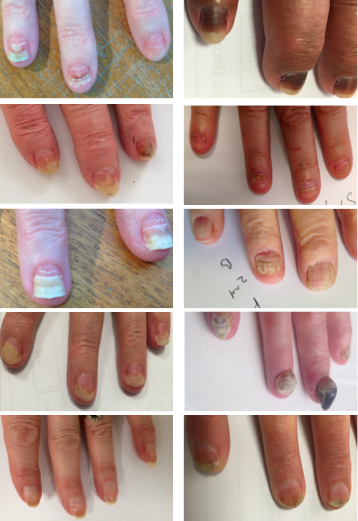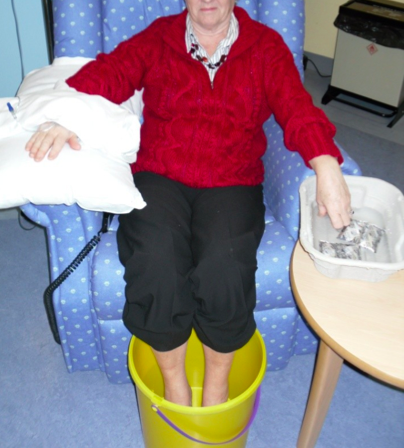 Nails and chemotherapy
Nails and chemotherapy
Nails are made by living stem cells and, because they are dividing rapidly, are especially susceptible to chemotherapy4,5,6. As a consequence, disfiguring nail damage is common, especially following regimens containing taxanes used for men with prostate cancer and women with breast cancer.
The type and severity of damage is variable, but most intravenous chemotherapies can cause ridges in nails, which correspond to the timings of chemotherapy episodes known as ‘Beau’s lines’. More pronounced chemotherapy nail damage leads to discolouration, brittle nails, acute paronychia (infection around the nail), onycholysis (nail separation) and sometimes even complete loss of the nail (see adjacent pictures). This damage is often unsightly and contributes to body image concerns during chemotherapy2 .
More serious consequences include pain, which can limit activities of daily living, and secondary infection. This is of particular concern when patients are also neutropenic (low white blood cell count) as the nails could be a source of more widespread infection. In addition to the killing of rapidly proliferating nail stem cells, damage is also thought to be due to chemotherapy’s anti-angiogenetic (preventing blood vessel growth) inflammatory properties4,5,6,7. If knocked, the nails can separate from the bed causing pain, secondary bacterial and fungal infections considerably increasing damage to the nail5,6,7.
How to prevent nail damage during chemotherapy
Firstly it is important to rule out other general and local medical conditions that could effect the health and appearance of nails, then treat or adopted preventative measures appropriately, if possible:
- Trauma to the nail bed
- Fungal infection of the nail bed
- Systemic diseases such as psoriasis
- Recent general infection or poor nutrition
 Although strong evidence is lacking attention should be made to the diet – see our nail health page. Before Polybalm® was developed, a variety of local strategies have been advised to patients during chemotherapy including petroleum based moisturising balms, wearing black nail varnish and cooling.
Although strong evidence is lacking attention should be made to the diet – see our nail health page. Before Polybalm® was developed, a variety of local strategies have been advised to patients during chemotherapy including petroleum based moisturising balms, wearing black nail varnish and cooling.
Moisturising balms: Many patient advocacy groups advise massaging moisturising balms into the nail bed, based on assumptions that oiling skin around the cuticles could improve compliance, thus preventing splitting which can be a route for infection and damage the nail bed. Although this seems intuitively beneficial there were no studies to support this practice or advise which balms to use and hence one of the rationale for the Polybalm® study.
Polybalm®: Following the significant results of the Polybalm® study, the investigational balm, now referred to as Polybalm® has to be regarded as standard of care to prevent nail damage. It is now commercially available, made in a special process which preserves the polyphenol content, and health medicinal properties, of the essential oils1,2,3,4. There were still some patients in the Polybalm® part of the study who experienced nail damage. This was seen in patients who had pre-existing damage who were particularly sensitive to the side effects of chemotherapy or had very high doses. In these cases additional measures such as cooling is still advised.
Nail varnish: Patients are also often advised to wear nail varnish despite the knowledge that nail polish removers dry the nails. Some people report this helps but, likewise, there are no published clinical trials to support this practice during chemotherapy, or in an otherwise healthy population.
Cooling the nails: We have previously published a report showing that cooling the nails bed with pots of iced water helps to reduce its severity 7. Understandably, the practice has never become widely adopted within the confines of a busy chemotherapy unit. Commercially available cooling gloves have now been tested in a number of randomised trials8,9. They were shown to reduce the severity of nail damage but they are not particularly popular among UK chemotherapy nurses as they cover the veins of the hands and prevent assessment of the patient’s extremities.
General dietary measures – See Nail Health page
For more information:
- Benefits of phytochemical after cancer and for general health
- Importance of gut health during and after cancer treatment
- Lifestyle tips after cancer
- Avoiding covid during cancer treatments and afterwards
- Help with other symptoms after cancer
References
- Delaquis P et al: Antimicrobial activity of essential oils. Int J Food Microbiol 74(1-2):101-9, 2002
- Smith-Palmer A et al: Antimicrobial plant essential oils. Applied Microbiol 26(2):118-22, 2002
- Baratta et al: Antimicrobial & antioxidant of essential oils. Flavour & Frag J 13(4):235-44, 2001
- Minisini AM et al: Taxane-induced nail changes. Ann Oncol 14:333-337, 2003
- Battegay EJ: Angiogenesis: Mechanistic insights. J Mol Med 73:333-346, 1995
- Wasner G et al: Docetaxel-induced nail changes: J Neurooncol 58:167-174, 2002
- Ding P & Thomas R: Solution for docetaxel onycholysis. Clin Focus Can Med 2(1):18-19, 2010
- Scottie F et al: frozen glove to prevent docetaxel-induced onycholysis. JCO 23 (19): 4424-29, 2005
- Ishiguro H et al: Freezing for docetaxel-induced nail toxicity. Sup Care Can 20:2017-2024, 2012
- lorian Scotté, et al. “Multicenter Study of a Frozen Glove to Prevent Docetaxel-Induced Onycholysis ” JCO 23 (19): 4424-4429 ( 2005).
- Ding P & Thomas R: A cool solution for docetaxel induced onycholysis. Clinical Focus on Cancer Medicine 2(1):18-19, 2010
- Katsimbri P, : Prevention of chemotherapy-induced alopecia using an effective scalp cooling system. Eur J Cancer 36:766-771, 2000
- Scottie F, et al: Muticenter study of a frozen glove to prevent docetaxel-induced onycholysis.JCO 23 (19): 4424-4429, 2005
